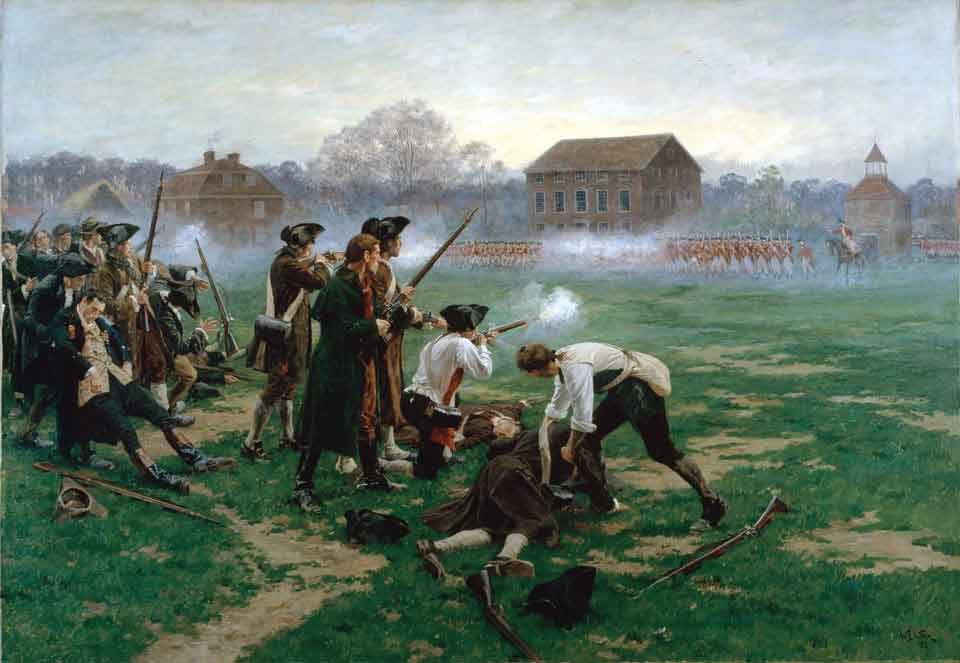Shortly after sunrise, Reuben Brown crouched on a hill just outside the center of Lexington, Massachusetts. He was out of breath from his six-mile ride from Concord, and what he saw didn’t make him breathe any easier. More than 700 British troops were on the road, and 70-odd provincial militia were all that stood between them and Concord.
He heard a single shot, then a thunderous volley as two companies of British infantry fired their muskets. He leaped onto his horse and raced back to Concord. In his haste to report what he witnessed to Major John Buttrick, he had left Lexington too soon to see the carnage on the green—eight provincial militia dead, and more wounded. Buttrick asked Brown if the King’s soldiers had been firing live ammunition. (Reluctant to believe the soldiers would kill fellow Englishmen, perhaps he hoped they were only firing powder to frighten the militia.) “I do not know,” said Brown, “but I think it probable.”
In April 1775, Reuben Brown was a 26-year-old maker of saddles, a trade he learned from his father in his home town of Sudbury. When he arrived in Concord in 1770, he had been “warned out,” urged to leave because of his precarious finances. But Massachusetts’ preparations for war helped his shop prosper. He supplied the militia with holsters, belts, and, most critically, cartridge boxes. Cartridges, each containing one musket ball and a pre-measured charge of powder, were vital to the minutemen’s performance in battle, allowing them to fire and reload three times a minute.

Cummings Davis, whose collection launched the Concord Antiquarian Society, posed with his dog, Don, in front of the Reuben Brown house in 1890.
| Concord Museum Collection; Pi1169a.In peacetime, the men of Concord had loaded their hunting guns from a powder horn and a pouch of musket balls—a painfully slow process. As war approached, they urgently needed cartridges. James Barrett, colonel of the minutemen, had a teenage granddaughter named Meliscent who feigned idle curiosity to persuade a British officer to show her how cartridges were made. She soon enlisted all the town’s young women to help her make the ammunition to fill Reuben Brown’s cartridge boxes.1
By the time the redcoats marched to Concord in 1775, Brown was a lieutenant in the minutemen, described by his neighbors as a “remarkably active, energetic, and intelligent man . . . For feats of agility or strength he was unsurpassed.”2 Both his intelligence and his physical fitness made him a good choice for the risky scouting mission to Lexington. Before the day was over, he would need all the powers he could muster.
No sooner had Brown returned to Concord than Colonel Barrett ordered him back into action as an alarm rider. He reportedly rode more than a hundred miles to spread the news of war to the militias of Hopkinton and other towns, which his fellow minutemen took as evidence not only of his “great physical strength . . . but also [his] patriotic feelings.”3
When the weary Lieutenant Brown finally made it back to Concord, the minutemen had won the day, but the retreating British troops had set fire to Brown’s harness shop on the Bay Road (now Lexington Road) before neighbors rushed to extinguish the flames.4 The British stole goods valued at nearly £275, of which £90 was looted from Brown’s property, including “saddles, bridles, stirrups, cartridge boxes, and a chaise [small carriage] commandeered to carry wounded officers back to Boston.” Later in the battle, Lieutenant Joseph Hayward would recover Brown’s chaise, killing a British officer in the process.5
After his prominent role on April 19, 1775, Brown chose not to fight in the American Revolution. Whenever he got a draft notice, he hired a substitute to serve in his place. He spent the war as a military supplier, contracted to outfit several companies. Although he reported losing $1,000 when one of his bills wasn’t paid, he seems to have found selling equipment to the army “profitable as well as patriotic . . . by the 1780s he was the most active creditor in town.”6

The Reuben Brown house in Concord was looted by the retreating redcoats in 1775. It is now a private residence and was once home to the Concord Antiquarian Society.
| Concord Museum Collection; Pi1170.1.After the war, Brown’s saddlery continued to thrive. He was admired not only for his business acumen, but also for being “kind to his neighbors, public spirited, and generous to the poor.”7 He became a charter member of the Social Circle, an elite group of twenty-five of Concord’s leading male citizens, pledged to “strengthen the social affections and diffuse useful communications among the members.” When his life came to an end in 1832, he was buried in the historic Hill Burying Ground, and left “a handsome estate to his heirs.”8
Much of the story of Reuben Brown’s life was recorded in a memorial essay by his Social Circle colleague William Whiting (1788-1862), who deserves a mention himself. A carriage maker by trade, he was also a proprietor of the Concord Academy and a member of the Concord Lyceum. He sheltered refugees from enslavement on the Underground Railroad, and welcomed abolitionist leaders Frank Sanborn, William Lloyd Garrison, Wendell Phillips, and John Brown into his Concord home. He had progressive ideas about education, too, insisting that his daughters receive the same education as his son.9
More than half a century after Reuben Brown’s death, his Lexington Road house (now a private home) earned its own place in Concord history. In 1850, Cummings Davis settled in Concord and began to collect “colonial artifacts with local histories.” By 1887, his collection had grown to some two thousand objects, and the newly formed Concord Antiquarian Society bought Reuben Brown’s old house to exhibit them, with Cummings Davis as a live-in curator. Davis died in 1896, but his historic artifacts remained in the Reuben Brown house under the Antiquarian Society’s care. They formed the core of the Concord Museum’s collection when it moved into its new building in 1930.10
The young saddler who nearly got run out of Concord as a deadbeat joined America’s struggle for freedom and turned his life around. His legacy lives on in the story of his deeds in 1775, in his contributions to the town’s growth, and in the house where he lived.
NOTES
1. Robert Gross, The Minutemen and Their World, Hill and Wang, 1976
2. Memoirs of Members of the Social Circle in Concord, Second series 1795-1840 (Riverside Press, 1888)
3. Ibid.
4. Allen French, The Day of Concord and Lexington, Little, Brown, 1925
5. Gross, op cit.
6. Ibid.
7. Memoirs of Members of the Social Circle, op cit.
8. Ibid.
9. Ibid.
10. concordmuseum.org/about/history-of-the-museum/


